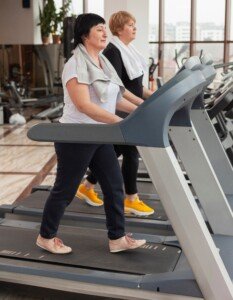
Is it really about balance issues for all those people who hold onto a treadmill?
Is it possible that the hoards of men and women who hold onto a treadmill while walking do so because of some “balance issue”?
You need not be formally trained in exercise science to understand some fundamental facts.
I once read some posts to an article about common cardio mistakes. One of the mistakes mentioned was “leaning on the machine.”
Many readers posted that they were guilty of holding onto a treadmill.
Then someone posted that she has “balance issues” and that there should not be a one-size-fits-all approach to using cardio equipment, and that people should do what they believe is “best for their body.”
That’s the problem: Just what IS best for your body?
Do you have any idea? Many people don’t have a clue, which is why so many women and men can’t lose the weight they want or can’t make the progress they dream of as far as physique development or fitness.
If you think you know what’s best for your body, chances are you’re wrong.
The Balance Myth
I can’t begin to tell you how many people have told me the reason they hold onto a treadmill is because they have “bad balance,” “poor balance” or “balance problems.”

I ask them if they’ve been diagnosed with a balance disorder. Of course, they say “No.”
I’ve had only one client with a disorder that affects balance: Meniere’s disease, and I had her using the treadmill without holding on.
There was another man at the gym who had significant muscle development in his upper body, but had weak, unstable, scrawny legs; he’d sustained permanent neurological damage from a spinal cord injury suffered in a motorcycle accident.
He’d always hold onto the treadmill when he walked. Ironically, he had no problem loading 45 pound plates onto a barbell — at shoulder height.
I told him to remove his hands from the treadmill. He was reluctant, but he complied. As I expected, he didn’t fall or lose his balance. He simply continued walking.
So when people tell me they hold onto a treadmill because of “balance,” I believe they simply don’t know better.
I hesitate to brand them as lazy, because if they were lazy, they wouldn’t even be on a treadmill.
Though sometimes, laziness is obviously the reason, particularly in those who ramp the incline to 15 percent, grip the bar like a vice and lean way back, completely cancelling out the incline.
In most cases, I believe it’s not knowing basic walking mechanics. Does this mean they don’t have a problem with balance if they let go? No.
However, the problem with balance isn’t a medical problem; it’s a learned problem.
The analogy is never removing the training wheels from a bicycle.
Imagine riding a bike with training wheels as you grow up into adolescence.
One day you get on a bike without training wheels. What will happen?
Chances are very high you’ll fall. At the least, you’ll struggle and have “balance issues.” In fact, you’ll feel very balance-challenged.
That’s because you’ve trained your body to adapt to an external support: the training wheels. You’ve deprived your body of developing its internal balance mechanism.
This is what happens when you’ve been holding onto a treadmill for a long time.

Freepik.com
Taking your hands off makes some people feel like they’ll fall off. Of course! Their body is trained to be dependent, not independent!
But why did they hold onto the treadmill in the first place?
Believe it or not, “Everyone else was doing it” has been named as a reason.
Another reason is because the rails and bar are there, and a novice’s hands will naturally gravitate towards them; a bad habit is born.
And I hate to say this, but sometimes this habit is born because a personal trainer set the novice client up for dependence by putting them on a treadmill and then saying something like, “If you feel off balance, hold onto the bar to steady yourself.”
This puts into the client’s head an expectation of balance problems, an endorsement of cheating.
Before you write yourself off as hopelessly balance-challenged, revisit the idea of walking on a treadmill with a natural, arm-swinging gait.
Do you really believe you’ll fall off if you try this at 2 mph?
If you’re nervous, then set the speed at 1 mph, and then increase by one tenth of a mile per hour every minute and see what happens.
 Lorra Garrick is a former personal trainer certified through the American Council on Exercise. At Bally Total Fitness she trained women and men of all ages for fat loss, muscle building, fitness and improved health.
Lorra Garrick is a former personal trainer certified through the American Council on Exercise. At Bally Total Fitness she trained women and men of all ages for fat loss, muscle building, fitness and improved health.









































